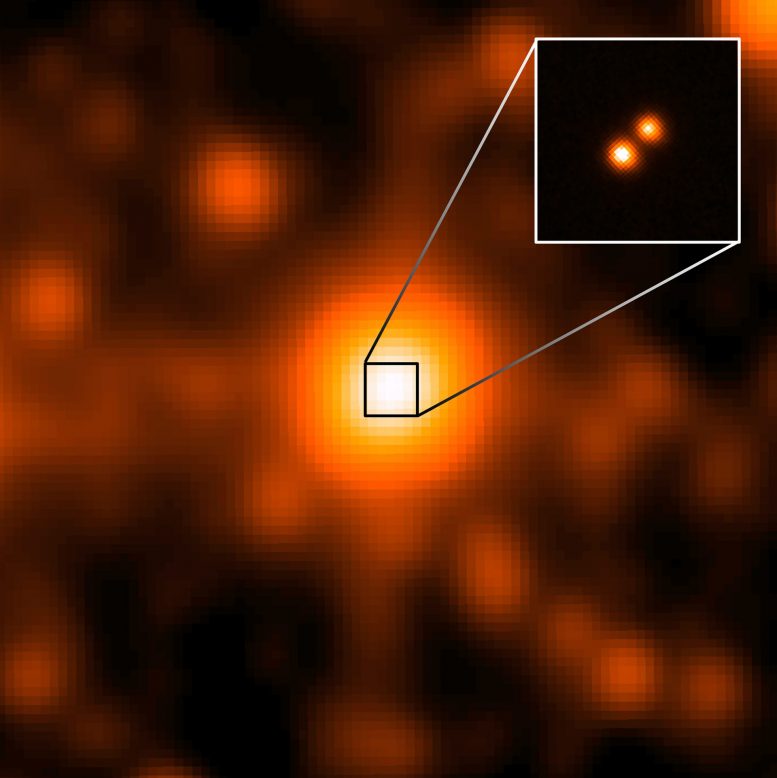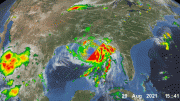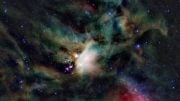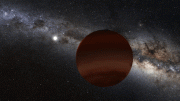
WISE J104915.57-531906 is at the center of the larger image, which was taken by NASA’s Wide-field Infrared Survey Explorer (WISE). This is the closest star system discovered since 1916, and the third closest to our sun. It is 6.5 light-years away. At first, the light appeared to be from a single object, but a sharper image from Gemini Observatory in Chile revealed that it was from a pair of cool star-like bodies called brown dwarfs. Credit: NASA/JPL/Gemini Observatory/AURA/NSF
Detailed analysis of the recently discovered Luhman 16AB system has revealed that the pair of failed stars may be harboring a planet.
Pasadena, California — Astronomers, including Carnegie’s Yuri Beletsky, took precise measurements of the closest pair of failed stars to the Sun, which suggest that the system harbors a third, planetary-mass object. The research is published as a letter to the editor in Astronomy & Astrophysics.
Failed stars are known as brown dwarfs and have a mass below 8% of the mass of the Sun—not massive enough to burn hydrogen in their centers. This particular system, Luhman 16AB, was discovered earlier this year and is only 6.5 light-years away.
After the discovery announcement, several teams of astronomers, including the one with Beletsky, used a variety of telescopes to characterize the neighboring couple.
After two months of observations and extensive data analysis, Beletsky’s team, led by Henri Boffin of the European Southern Observatory (ESO), found that both objects have a mass between 30 and 50 Jupiter masses. By comparison, the Sun has a mass of about 1,000 Jupiter masses.
“The two brown dwarfs are separated by about three times the distance between the Earth and the Sun. Binary brown dwarf systems are gravitationally bound and orbit about each other. Because these two dwarfs have so little mass, they take about 20 years to complete one orbit,” explained Beletsky.
The team used the FORS2 instrument on ESO’s Very Large Telescope at Paranal to image the brown dwarf couple in the best possible conditions, every 5 or 6 days over the period April 14, to June 22, 2013. Because the instrument enabled the observers to make very precise measurements, the scientists were already able to detect tiny displacements of the two objects in their orbit during only this two-month period.
The astronomers were able to measure the positions of the two brown dwarfs with ten times better accuracy than before and thereby detect even small perturbations of their orbit.
“We have been able to measure the positions of these two objects with a precision of a few milli-arcseconds,” said Boffin. “That is like a person in Paris being able to measure the position of someone in New York with a precision of 10 centimeters.”
The measurements were so fine that the astronomers were able to see some very small deviations from the expected motion of the two brown dwarfs around each other. The fact that the deviations appear correlated is a strong indication that a companion perturbs the motion of one of the two brown dwarfs. This companion is most likely a planetary-mass object, which has an orbital period between two months and a year.
“Further observations are required to confirm the existence of a planet,” concludes Boffin. “But it may well turn out that the closest brown dwarf binary system to the Sun turns out to be a triple system!”
The team is composed of Henri Boffin, Kora Muzic, Valentin Ivanov, Andrea Mehner, Jean-Philippe Berger, Julien Girard, Dimitri Mawet (ESO, Chile), Dimitri Pourbaix (Université Libre de Bruxelles, Belgium), Rudy Kurtev (Universidad de Valparaiso, Chile), and Yuri Beletsky (Carnegie Observatories at Las Campanas Observatory, Chile).
Reference: “Possible astrometric discovery of a substellar companion to the closest binary brown dwarf system WISE J104915.57–531906.1” by H. M. J. Boffin, D. Pourbaix, K. Mužić, V. D. Ivanov, R. Kurtev, Y. Beletsky, A. Mehner, J. P. Berger, J. H. Girard and D. Mawet, 23 December 2013, Astronomy & Astrophysics.
DOI: 10.1051/0004-6361/201322975
arXiv:1312.1303









Would this third body orbit just one of the brown dwarves or would it orbit about the center of mass for the two of them? Either way, isn’t this system inherently unstable? One would expect the constantly changing gravitational forces exerted by the brown dwarves to eventually destroy the planet’s orbit.
no, that’s not true. If the planet is far enough this won’t matter. It will just orbit the center of mass. Of course if it comes too close, the relativistic decrease of the distance from the planet to the two host stara and the fluctuations between them will disrupt the orbit.